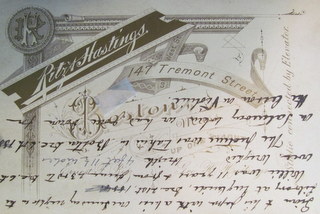In the infamous liquor boxes I’ve got stashed
in the upstairs closet, there must be fifty or so of those wonderful cabinet
shots—those stiff, cardboard photographs of some of my stiff ancestors posed in
various photographic studios. I love the props—the chairs and tables, the
fences and sofas—that those photographers used to set up the shots; the
curtained backdrops are dead giveaways, aren’t they?
At
any rate, I’ve been looking at the cabinet cards themselves, especially the
photographers’ imprints on the bottom front (and/or back): logo, address, etc.
Some
of them are just wonderful…
…two front imprints from the studios of
Chickering (on West Street in Boston) and one from Benjamin Freeman in
Somerville, both from the 1880s…
…and here’s a backside imprint from A.R.
Fowler in Meadville, Pennsylvania (my paternal grandmother came from there…).
Look
at the flowers!!!
Here’s the backside of a portrait of Emma
Tidd, a friend of my great-grandmother’s, taken by P.H. Rose. He was a very
successful photographer in Providence, Rhode Island; his studio was in the
Conrad building (see illustration) on Westminster Street.
I’ve got a cabinet shot of my grandfather,
William Wescott Howell, taken in 1884 in Boston at the Ritz & Hastings
studio on Tremont Street. On the backside, there’s a fancy imprint for the
business, and a lengthy inscription written by my great-grandfather on the
occasion.
For those of you who don’t wish
to stand on your heads, the inscription reads:
Given to his papa with a kiss one Sunday night in the Library at
Ingleside, Dec. 21st, 1884. Willie was 11 years & from June 23rd
to Dec. 6th Will weighed
Heighth 4 feet 11 ½ inches. The picture was taken in Boston Dec. 6th,
1884 on Saturday when we had gone down for the lesson on Violin.
That might be more than we need to know, but
I’m awfully glad to know his “heighth.”
























